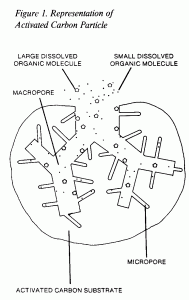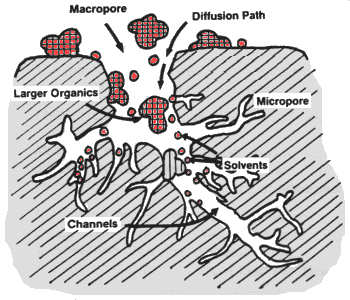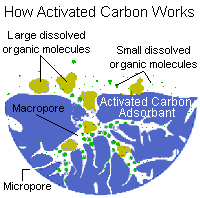Micropores, Minipores, Molasses and Iodine
by Gene Franks
Filter carbon, the most basic ingredient of numerous water treatment devices, is a manufactured product. It is made from base materials like coal (bituminous, sub-bituminous, or lignite), coconut shells, wood, peat, fruit pits, nutshells and more.
Each of these substances has unique characteristics that make the resulting carbon perform uniquely. For example, lignite carbon and carbon made with  certain woods are best at removing colors like tannins from well water; coconut shell carbon is known for its ability to remove disinfection by-products and volatile organics; bituminous carbon gets the “best all-around” prize for doing almost everything pretty well.
certain woods are best at removing colors like tannins from well water; coconut shell carbon is known for its ability to remove disinfection by-products and volatile organics; bituminous carbon gets the “best all-around” prize for doing almost everything pretty well.
There is a reason why each carbon product is uniquely suited for specific jobs.
The base material is prepared for use as filter carbon by a special activation process that involves high temperatures in a low-oxygen environment, followed by high pressure treatment with steam, carbon dioxide, or acids. The goal of activation is to produce a product with a complex pore structure that has a strong attractive power for organic molecules. It is the size and arrangement of the pore structure that makes each carbon uniquely suited for the reduction of specific contaminants.
Carbon makers have rating systems to measure their products’ performance. These rating criteria are many: ash percentage, bulk density, abrasion number, and peroxide number, for example. In regard to pore size, which we are concerned with here, the main classifiers are the molasses number and the iodine number.
The molasses number measures carbon’s large pores, know as macropores, which are officially defined as pores with a diameter of 0.01 microns (1,000 angstroms). The higher the concentration of macropores, the higher the molasses number.
On the other hand, micropores, which have a diameter of less than 0.01 microns, are considered when assigning the carbon its iodine number. The iodine number expresses the milligrams of iodine than can be adsorbed by one gram of activated carbon. Iodine is a very small molecule and it takes carbon with small pores to adsorb it effectively.
Carbon with a high molasses number is best at adsorbing organic contaminants with a high molecular weight; a high iodine number indicates that the carbon will be good at removing contaminants with a very low molecular weight.
Water Filtration, a training and reference book published by the Water Quality Association, uses the analogy of a parking lot to explain how organic chemicals are adsorbed on filter carbon. I’m going to paraphrase:
The inside surface of the activated carbon particle can be viewed as a large parking lot for organic molecules. Further, one can view the large molecules as semitrucks, and the small organic molecules a compact cars. . . . If most of the pores in the activated carbon are micropores (small parking spaces), the semitrucks are going to have a difficult time moving inside the parking lot, and they will have difficulty finding a parking site which fits. But, the compact cars will have an easy time. [This parking lot has a high iodine number.] Second, if the pores are mostly macropores (large parking spaces), the semitrucks will be able to get around fine, but it will be an extremely inefficient way to park compact cars. [This lot has a high molasses number.] If there are only a few roads connecting the various areas inside the parking lot, the cars will all pile up, and the roads will act as a bottleneck. Ultimately, a large number of small cars can be parked, but the parking lot will fill slowly. This is what happens if there is not a suitable mix of micropores and macropores [as would be the case with a well balanced, bituminous carbon].
One final thing to note is that there are miles and miles of roads and lots of parking spaces in a relatively small amount of carbon. It is estimated that a teaspoon of activated carbon has a total surface area equal to a football field. That’s why carbon is a prominent ingredient of almost all water treatment devices that aim at reduction of chemicals, disinfectants, colors, odors, and much more.





